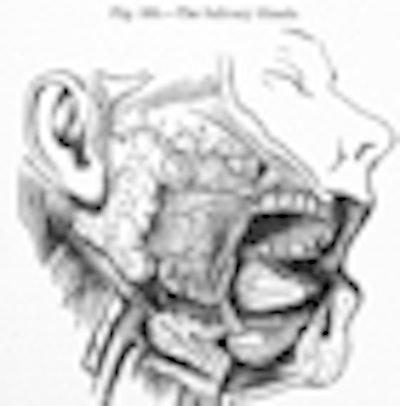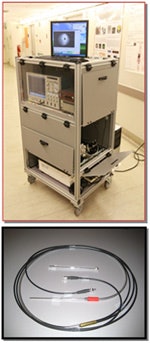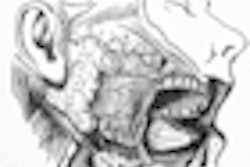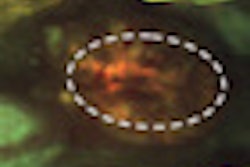
Researchers from the University of California, Davis are conducting in vivo experiments of a noninvasive, laser-based device that could aid in the early detection of oral and head and neck cancers (Otolaryngology -- Head and Neck Surgery, June 2010, Vol. 142:6, pp. 838-844).
Laura Marcu, Ph.D., a professor of biomedical engineering at UC Davis, collaborated with D. Gregory Farwell, M.D., and others in the department of otolaryngology at the UC Davis Cancer Center to develop the fiber-optic probe, which uses time-resolved fluorescence spectroscopy to provide molecular information of the tissue being imaged. Optical energy from a 337-nm laser stimulates the molecules, some of which naturally respond by re-emitting fluorescent light.
“This is a label-free diagnostic.”
— Laura Marcu, Ph.D., University of
California, Davis
Most studies involving fluorescence spectroscopy in head and neck tumors focus on spectral intensity measurements, the researchers wrote. Much less investigation has been geared toward time-resolved techniques, which examine the length of time that a given fluorophore -- such as collagen or reduced nicotinamide adenine dinucleotides (NADHs) -- emits light, and this fluorescence decay is expressed in terms of lifetimes.
Time-resolved fluorescence offers several advantages, they added. For example, the lifetimes are sensitive to many variables within the biological microenvironment, such as pH, ion concentration and binding, enzyme activity, and temperature, allowing these factors to be analyzed. In addition, biomolecules with overlapping fluorescence emission spectra but different fluorescence decay times can be discriminated.
"337 nm excites representative endogenous fluorophores in tissue, thus fluorescence lifetime contrast can be achieved in order to discriminate between tumors and normal tissue," Marcu told DrBicuspid.com. "This is a label-free diagnostic."
First human studies
Following encouraging results in animal tests (Archives of Otolaryngology -- Head and Neck Surgery, February 2010, Vol. 136:2, pp. 126-133), the UC Davis team recruited nine human volunteers from among patients who came to the UC Davis Medical Center for surgical therapy of the mouth, throat, and larynx -- making this one of the first in vivo investigations of time-resolved fluorescence spectroscopy for this application, Marcu noted.
 |
| The laser-based time-resolved spectroscopic system developed at UC Davis for early detection of head and neck cancers. Images courtesy of Laura Marcu, Ph.D. |
In the operating room, a nitrogen laser was used to induce tissue autofluorescence of normal tissue and suspected malignant lesions. The fiber-optic probe was placed perpendicularly to the surface of the mucosa and held in position by the surgeon. Each sample investigated was 1 mm in diameter.
The researchers collected steady-state and time-resolved spectroscopy information. The fluorescence emission of each sample was scanned in the 360- to 610-nm range at 10-nm intervals. A total of 53 sites were measured.
When Marcu and her team compared spectral intensities and time-domain measurements from the time-resolved fluorescence system with histopathology samples from the same locations, they found that the probe could accurately diagnose the cancer in the surgical environment.
Differences in spectral intensities allowed for discrimination between malignant and normal tissue. Across all wavelengths between 360 and 610 nm, the absolute fluorescence intensity was significantly decreased in carcinoma compared to normal mucosa. Significant spectral intensity peaks of normal and malignant tissue were noted at two spectral bands: 370-400 nm and 440-470 nm, which correspond to collagen and NADH fluorescence, respectively. The lifetime values at 440-470 nm were significantly different between normal and malignant tissue, the researchers noted.
"This was an interesting approach because they are looking not just at the presence of fluorescence but the length of time the fluorophore emits light and the fluorescence decay over time, not just the presence or disruption of the fluorophores" said Mary Reid, Ph.D., an associate professor of oncology at Roswell Park Cancer Institute, whose group has been working with autofluorescence-guided visualization to enhance oral cancer detection. "It also takes into account the other things in the environment, such as hemoglobin absorption. So it has the potential to be a more sensitive measure."
More research needed
Marcu and her colleagues are now looking to further validate the system to account for all possible conditions in the oral cavity and neck region, she added -- noting that, depending on the tumor location (tongue, vocal cords, palate, etc.), "normal" has different characteristics. Being able to better distinguish normal from malignant tissue particularly in the tongue region would be an important advance, Reid said.
"In head and neck cancer, the tongue is a major problem area," she said. "The tongue is very muscular, often has multifocal disease, and a lot of the treatment failures occur there. But in this study you can see that, when you look at the tongue data, there is a lot of overlap between malignant and normal tissue. For the vocal cords, when there is malignant tissue, it is much more straightforward. You see distinct peaks. So this is a problem that definitely needs to be worked out."
In addition, while Marcu and her colleagues state that one of the study limitations is the lack of normal healthy controls, Reid disagrees.
"This technology has to be used in people who are high risk," she said. "We want the smokers and drinkers. That is how we are going to develop these diagnostic technologies -- by focusing on those most at risk. We are a long way off from this being used like a Pap smear."
Marcu and her colleagues are also working to develop similar devices that can provide near-real-time diagnostic information to physicians during oral surgery, she said. While the nitrogen laser is "quite practical," Marcu said, it could be replaced with a fiber laser or solid-state laser in the future to create a more compact and lower-cost device.
"Our hope is that this technology can leave more of the patient's tissue in place because taking out an extra centimeter could be the difference in impacting swallowing, speech, or disfigurement," Dr. Farwell said in an interview with the university newspaper, the California Aggie.
Copyright © 2010 DrBicuspid.com



















